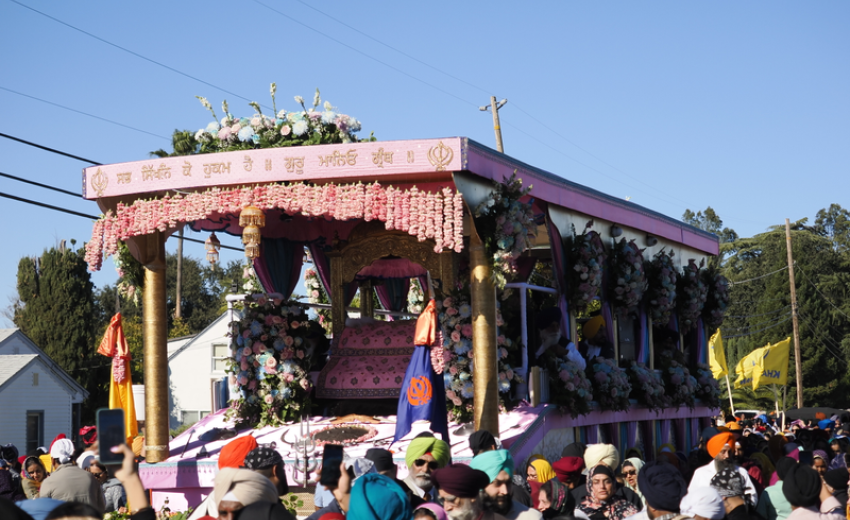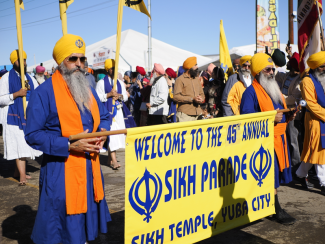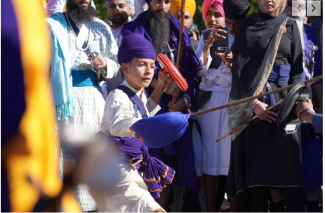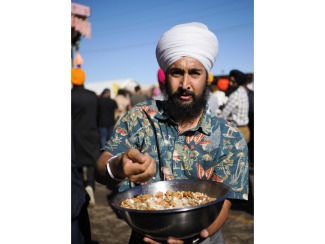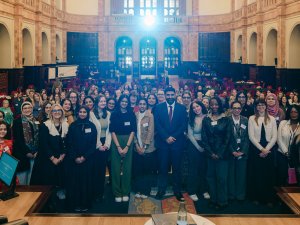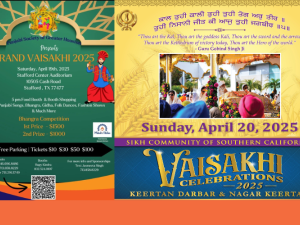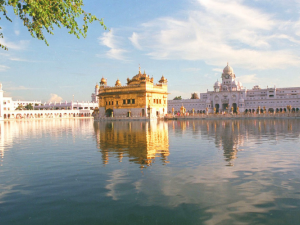The Annual Sikh Parade is a three-day event that occurs every November, no matter the weather, drawing 200,000 Sikhs to Yuba City. The Yuba City Nagar Kirtan is the largest festival outside of India that celebrates Guru Gadee Diwas. The Annual Sikh Parade is hosted by Gurdwara Sahib Yuba City, 2468 Tierra Buena Road, Yuba City, California, 95993. The parade features a long line of 20 or more floats representing various gurdwaras throughout California. Floats filled with singing worshipers, accompanied by worshippers on foot, stretch out over several blocks as the parade loops through the city taking six hours to return to the gurdwara. The streets along the parade route are blocked off, patrolled by officers on foot and horseback, and lined with spectators. Colorful stalls and booths including stands offering free food fill the gurdwara grounds and are set up along both the sides of the streets the first mile or so of the parade route.
Guru Gadee Diwas – refers to the day (diwas) of the enthronement (gadee) of Sri Guru Granth Sahib, the eternal Guru of the Sikh Panth, or nation, which occurred on October 20, 1708.
Nagar Kirtan – is a parade that carries Guru Granth Sahib through the town (nagar) and expresses adoration (kirtan) by singing hymns (shabads) of praise.
Three Days of Guru Gadee Celebrations
Friday festivities begin with vendors setting up the bazaar with stalls and booths featuring a wide variety of items for sale including Articles of Faith (5 K’s kachhera, kanga, kara, keski, and kirpan), Books, Blankets, Clothing and Fabrics, Food items for sale, Free giveaways, Games, Kirtan recordings, Shawls, Toys, Turbans, and Utensils etc. Every year more and more items pop up in an array of dazzling colors. In 2024, despite the rain, festivities started with a bang featuring 30 minutes of fireworks on Friday evening, followed by Kirtan at 8 pm.
Saturday celebrations begin with raising the Nishan Sahib (flag) at 9 am, and at 10 am, an open house tour of the gurdwara. During the the day, Floats are assembled, and decorated for the parade.
It is also a time for events like the Sikh Heritage Society’s annual symposium held at the Sikh Community Center in Yuba City where, in 2024, art curator Sonia Dhami talked about “Women of The Sikh Empire” and how art bridges religion and heritage. Dr. Gurpreet Singh Dhugga gave a talk on Maharaja Ranjit Singh and his efforts to educate his subjects in Farsi and mathematics. Dr. Loius E. Fecech, a professor and scholar of Sikh history from the University of Iowa, spoke on the subject, “Between Miri and Piri” about Guru Gobind Singh and the role of the Panj Pyara (5 beloved) administers of Amrit, in the Sikh initiation of Khalsa. Rupinder Singh Brar MD FACC, a physician who is the Director of the Adventist Heart and Vascular Institute in Yuba City is a historian and author who answered questions about the subjects of his three books. Gurpreet Kaur commented, as did intern Jagsher Singh Mann, on the Punjabi Digital Art (PDA) display which included 51 pieces of digital art.
Rain Sabhaee (night so beautiful) Kirtan is traditionally held at the Gurudwara from 6 pm until midnight.
The first Sunday in November is the main Nagar Kirtan event in Yuba City and coincides with clocks being turned back to change from Pacific Daylight Savings Time (PDT) to Pacific Standard Time, (PST). Parking lots all around the gurdwara begin filling up. The floats line up on a road alongside the Gurdwara. Last-minute decorations are done. Floats are scheduled to start rolling out at 11 am. Meanwhile, the main float is brought to the front entrance of the gurdwara.
The Panj Pyare (five beloved ones) assemble with swords raised. Ardas is done, and an Attendant carries the Guru Granth Sahib from the gurdwara to the float atop his head. Another attendant follows behind with an Umbrella raised over the Guru Granth Sahib. Worshipers gather around and observe as they mount the canopied float that will carry Guru Granth Sahib through the streets of Yuba City.
The parade begins at Tierra Buena Road and proceeds to Butte House Road, Civic Center Boulevard, Poole Boulevard, and Tharp Road, returning to the gurdwara via Butte House Road. Spectators and worshippers throng along every vantage viewing point every inch of the way.
The parade route is washed down by a truck spraying water on the street. Worshippers sweep the road with brooms walking barefoot ahead of the main float which is first in line. The Panj Pyare walk side by side with swords raised ahead of the float. Worshipers flock around the float often touching the sides. The other floats fall in line. Pickup trucks, semi-trucks, or tractors move the floats. There are two main types of floats. Those sponsored by a specific gurdwara, or Sikh organization, often carry worshippers singing shabads (hymns) or display historical shrines, Sikh martyrs, or important issues and events. Nearly every float has a loudspeaker.
Many of the most elaborate floats are shared between Gurdwaras around the United States at different times of the month or year. Sikhs from all over the United States and as far away as Canada participate in centenary celebrations. As more worshipers join the procession, each individual becomes immersed in a surging wave of color dotted by a sea of vibrant turbans bobbing in a living ocean of sound.
Langar (vegetarian food from the Guru’s free kitchen) is always available at the Gurdwara. There are also Langar stations outside on the gurdwara grounds and along the parade route. Sikhs stand in the street to hand free food and drinks to passers-by. Sarson ki Saag with Makki Roti (turnip greens, or spinach with corn flatbread), Chhole Poori (chickpeas with deep fried flatbread), Challi (charred corn on the cob roasted over an open flame), Ganne Ka Ras (freshly pressed sugar cane juice, lemon, and ginger) are among the traditional free food flavors one might encounter. Bottled water, soft drinks, snack packs, and chips are free favorites with the younger set.
Gatka martial artists demonstrate their bravery and skill with shastar (traditional weaponry) whirling chakkars (a circular spinning weapon) overhead, and hand-to-hand combat with sticks and swords. Though accidents are rare, they can and do happen.
Departure
Towards evening the floats return to the gurdwara. The procession of 200,000 worshippers disperses to indulge in last-minute shopping at the bazaar, partake of langar, take prashad in the gurdwara worship hall, and offer their respects before returning to their vehicles. Some will head home or go to visit friends. Others will begin the loving process of breaking down the floats, dismantling the stalls, and booths, packing up their goods, washing pots, and pans in the langar hall, picking up trash, and cleaning the gurudwara grounds until all traces of Nagar Kirtan are removed until the following year when Guru Gadee Diwas happens all over again.
